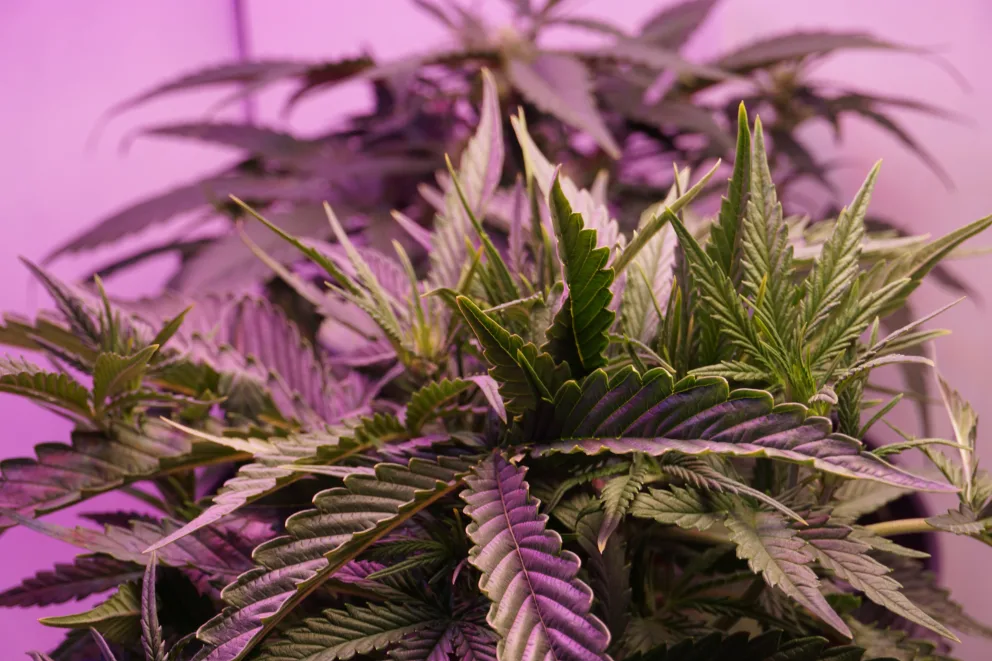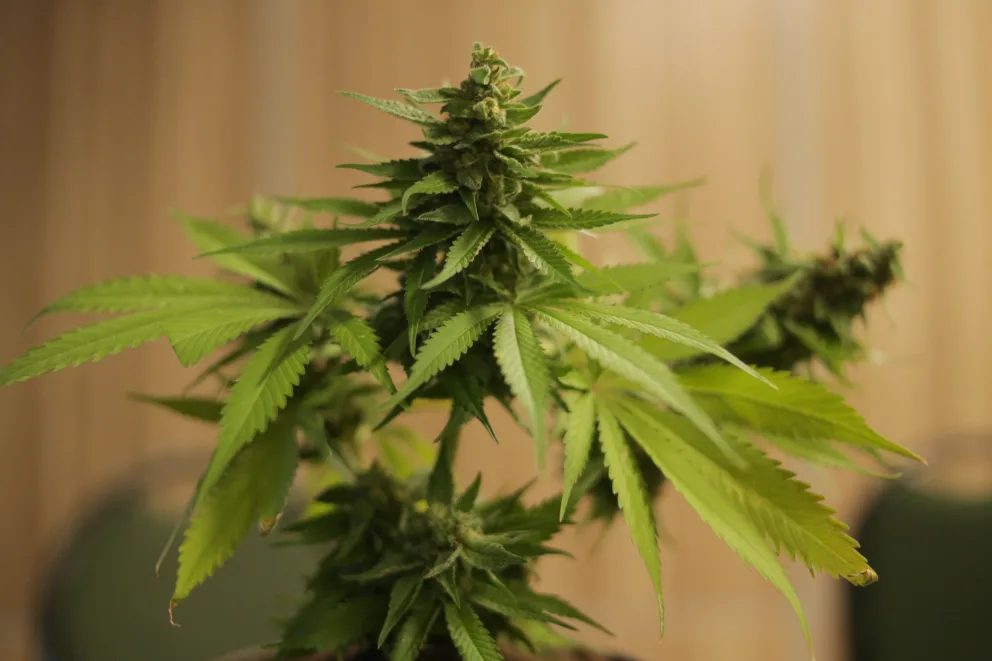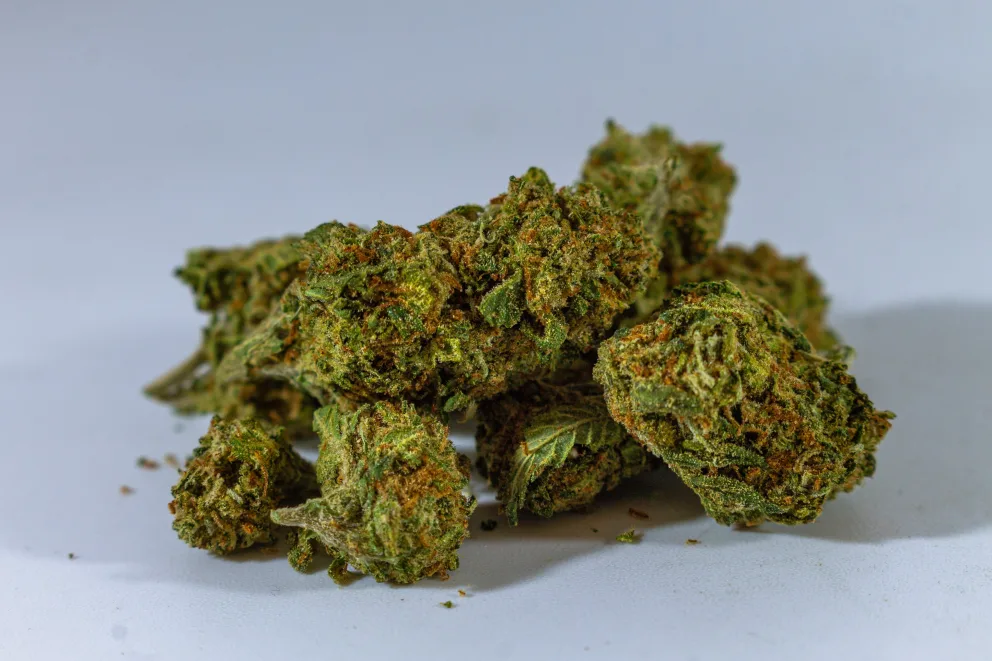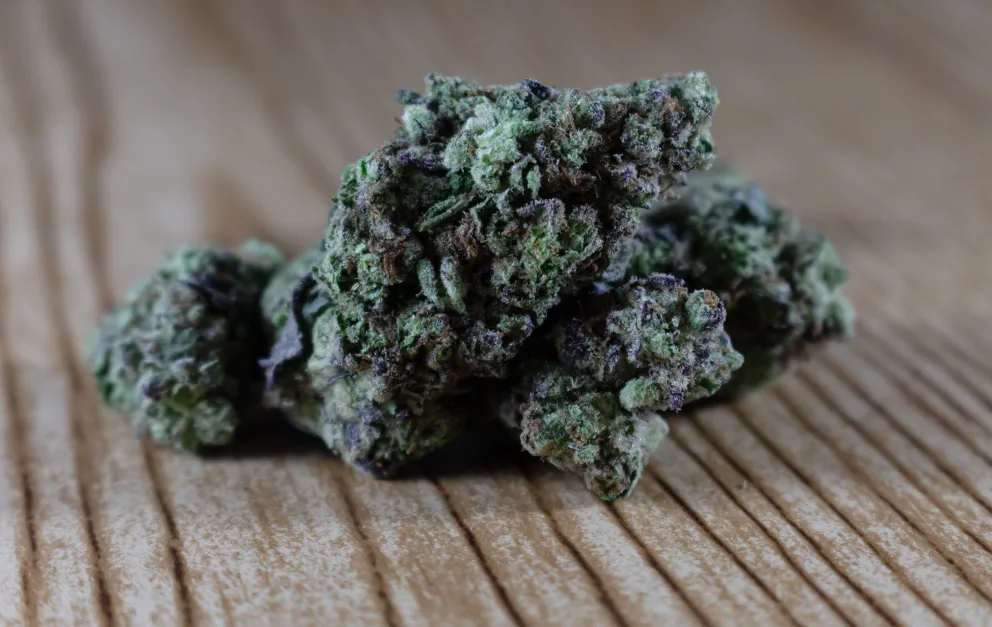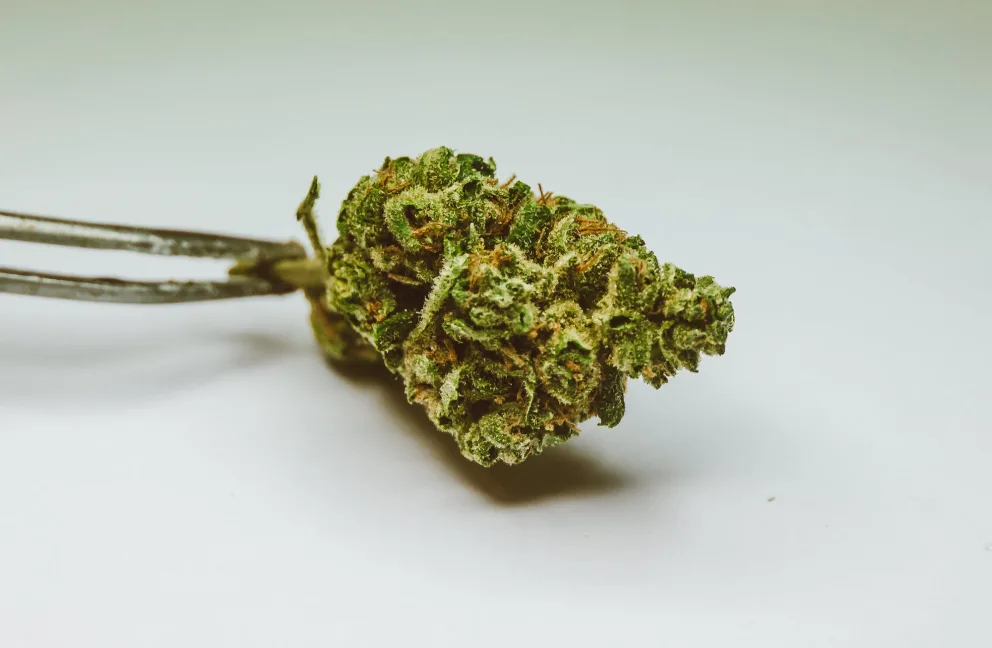
Photo by Jane Doan
THC has driven much of the world’s love affair with cannabis and a fair amount of its controversy, after all, the only thing separating legal weed from hemp is its THC content. However, it’s not the only important compound in cannabis. What about terpenes?
Terpenes are chemicals found in everything from lavender essential oil to organic pesticides to your favorite fruits and veggies. Thanks to expanding medical marijuana legalization we are discovering how terpenes seem to have countless potential medical applications.
Terpenes are proving to be potent antioxidants, anti-inflammatories, potential cures for diseases and conditions, and natural pain relievers. What exactly are terpenes? What do terpenes do in plants? What do they do in the human body?
Terpenes are what give plants their distinct flavor and taste. They are found throughout the plant kingdom and serve various roles in keeping plants alive. In cannabis, they combine with cannabinoids and flavonoids to affect the human body in something called the entourage effect.
Terpenes are fascinating substances that serve various benefits in plants and human beings.
This in-depth guide will cover everything you need to know about the world of terpenes, their various impacts on the flavor and scent profile of not just cannabis strains but your favorite foods and how they can benefit your health.
[fl_builder_insert_layout id=13138]
What are Terpenes?
Terpenes are a classification of organic compounds produced by plants that are responsible for their overall fragrance, flavor, and even in some cases their pigmentation. While humans and animals can perceive these fragrances as delicious or disgusting, terpenes are serving important functions in the plants’ physiology.
Terpenes can attract pollinators while repelling potential predators and pests. They interact with other chemicals in the plant to produce specific effects and functions. For example, terpenes also kick in to protect plants from high temperatures, drought, radiation and other stressors.
Terpenes are also commonly cultivated from plants to make fragrances, cleaning solvents, pesticides, dyes, and both natural and artificial flavorings.
Photo by Jane Doan
How Many Terpenes Are There?
There have been more than 20,000 different terpenes discovered throughout the plant kingdom with the number totalling 55,000 distinct chemical entities.
More than 200 terpenes have been found in the cannabis plant with the terpene breakdown being significant in giving different cannabis strains their distinct scent and flavor profiles.
Despite their scent significance, the diverse physiological effects on human beings as well as how different terpenes, and combinations of terpenes via the entourage effect, have made them a topic of distinct scientific interest.
Terpenes can work synergistically with cannabinoids like THC and CBD where the therapeutic effects of cannabis can be amplified and modulated.
The entourage effect is how scientists outline the effects of all of the various compounds work together to impact your body. Rather than the countless individual chemical reactions the focus is on the net result and overall effect of these numerous chemical interactions.
Even small amounts of terpenes can influence the overall effects and medical value of a cannabis strain because they can increase the bioavailability of some compounds or amplify how they might affect you. For example, pinene can be highly beneficial if you ever become too high or anxious from THC as it neutralizes some of the psychoactivity of THC.
Every chemovar (chemical variety) or strain of cannabis consists of a diverse terpene profile. The varying concentrations of terpenes will not just determine its unique aroma, flavor but also some of its medicinal qualities.
For example, pinene, myrcene and limonene tend to dominate most strains but over a dozen secondary terpenes play a vital supporting role. Traces of minor terpenes can still impact the overall effect. Again, it’s an entourage of various chemical interactions that create a net result in your body.
As cannabis breeding and research continues, cultivators have begun to isolate targeted terpene profiles. However, nature creates intricate terpene synergies that science has yet to recreate and even fully discover. Preserving cannabis chemovar diversity remains crucial.
Photo by Alexander Grey
What Major Terpenes Are Found in Cannabis?
Again, while there are more than 200 terpenes some of the power player terpenes found in cannabis include:
- Myrcene Myrcene is the most common terpene in cannabis and its musky, earthy, herbal notes are majorly responsible for the distinct marijuana scent. It’s known for its sedative and anti-inflammatory effects.
- Limonene Limonene has a citrusy aroma and is found in many of those fruits. It tends to have uplifting, stress-relieving qualities and is a powerful antioxidant.
- Linalool Linalool has a floral, spicy aroma and is responsible for the distinct lavender scent. It’s used in 60-80% of all household products. Linalool can also provide relief for anxiety and depression.
- Caryophyllene Caryophyllene has a spicy, peppery scent and is known for its many anti-inflammatory and pain-relieving properties. It also can bond to CB2 receptors in the endocannabinoid system like CBD.
- Pinene Pinene is responsible for the distinctly “piney” aroma of many evergreen plants. In the body, it tends to enhance focus and counter memory problems.
- Humulene Humulene has a woody, earthy scent. It’s known for its pain relieving and anti-inflammatory properties. It’s also been shown to have some appetite suppression benefits which can help mitigate the munchies.
- Terpinolene Terpinolene is not quite as common and found in one out of ten cannabis strains. It has a nuanced flavor that’s floral and common in lilacs but also with some woodsy cedarlike notes. It’s known for its energizing effects and is often found in Sativa strains.
Other secondary cannabis terpenes include: ocimene, eucalyptol, borneol, camphene, nerolidol, phytol, eugenol, bisabolol, farnesene, geraniol, guaiol, isopulegol, sabinene and more. Again, these all combine to create a singular benefit of each strain and different environmental factors can trigger different crops to have varying levels of terpenes. Again, we can often take for granted what works in humans has its origin in keeping plants alive. Speaking of…
Photo by Brokkelen.nl
What Do Terpenes Do In Plants?
Terpenes serve a few different roles in plant physiology and how plants interact with the world around them. They support ecological roles and have co-evolved with other plants, living things and their environments for over millions of years.
Different environmental triggers can activate the production of certain terpenes because terpenes play a role in plant growth. Terpenes manage immune responses, the adaptation to key temperature changes, drought resistance and are the result of other reactions to nature. While we may just observe their function as scents and flavors these do serve important biochemical roles in plants including:
Defense
Many terpenes act as repellents or toxins that ward off insects and other animals that might try to eat them. Their strong aromas can deter herbivores and potential pests. For example, when insects try chewing cannabis leaves, bitter sesquiterpenoid flavors make the plant taste inedible. Many terpenes can also be antimicrobial, antifungal, and antibiotic which help prevent plants from infections and infestations. This overall effect can often extend to the humans and animals that consume them.
Attraction
Floral terpenes attract pollinators like bees, butterflies, birds and other living things that help spread pollen to fertilize plants. Sweet fragrances draw pollinators to the flowers so they can collect pollen while consuming nectar.
Plants can also produce attractive scents in their fruits or other edible parts so animals will consume them and then excrete viable seeds which help propagate the plant.
Resin Production
One role of terpenes, especially in conifer trees, is to contribute to resin formation. Resins can sometimes behave like blood in humans. Resin helps protect plants from insects and pathogens that may try to penetrate the bark and disrupt vascular tissues.
Thick resin creates a barrier that can waterproof and seal “wounds.” For example, when you cut into a tree it may release sap to seal the area. It can even be used to trap potential insects and pests. If you remember Jurassic Park, many of those insects were trapped in amber a.k.a. fossilized resin because the plants were defending themselves.
Resin can also contain antibiotic and antimicrobial agents like lymphatic fluid does in people. These terpenes can function in protecting vulnerable plant parts from the potential infestation or infection by attacking pathogens in those areas.
Temperature Regulation
Similar to functioning like blood, terpenes can also be components in for lack of a better term plant sweat.” By releasing terpenes into the air around leaves, plants can cool themselves down.
Terpenes are highly-volatile compounds meaning they easily transition from liquid to gas phase. As terpenes evaporate quickly, they can absorb the heat energy from the surrounding air and effectively bring the plant’s temperature down.
The evaporation of terpenes has a local cooling effect, allowing plants to maintain optimal temperature conditions even in hot weather. It’s even similar to sweating in that plants often expel water and terpenes out of the stoma which are small pores in plant leaves. Who knew we had so much in common?
Heat & Radiation Reflection
While plants can convert energy from sunlight they’re not immune to UV radiation. Some terpenes are very reflective molecules, meaning they can effectively bounce solar radiation away from the plant before it’s absorbed and causes overheating.
By releasing terpenes onto leaf and needle surfaces, plants can form a reflective layer that shields vulnerable plant tissue from excess solar infrared and ultraviolet radiation by diffusing and reflecting some of that radiation.
Pigmentation
Terpenes even help create some of the vivid colors of some plants and fruits. Terpene pigments like carotenoids which make carrots orange create striking colors to serve as attractive signals to animals. Animals then eat fruit and disperse seeds and other undigested plant parts in their waste which can grow into new plants.
It’s interesting to think how interconnected plants are with the living things around them. This is part of what is driving the intense interest in what terpenes can do to help with health.
Photo by Wallace Araujo
How Do Terpenes Affect The Body?
Again, we may see terpenes as only flavors and fragrances but some of the health benefits they serve in plants also help human beings. Also, wide-ranging therapeutic effects of terpenes are still being discovered.
Terpenes have several physiological mechanisms that engage with our bodies. Here’s a few ways terpenes engage with the human body and what that means for your health:
Binding to Neuroreceptors
Like cannabinoids, some terpenes can directly activate or modulate receptors in the brain and body. We have an entire endocannabinoid system with CB1 and CB2 receptors throughout our body that turn up and down certain body functions.
THC and CBD usually impact CB1 and CB2 receptors respectively and some terpenes can, too. Terpenes can also engage with receptors of the human nervous system.
Terpene-wise, humulene can weakly bind CB2 receptors. CB2 receptors govern inflammatory responses and this explains their antiinflammatory functions.
Borneol is a known agonist of 5HT3A serotonin receptors. This means that it can mirror the function of serotonin and bond to these receptors causing similar functioning.
Some of this binding to neuroreceptors can be neuroprotective. For example, borneol has been found to have some potential in protecting neurons from potential degradation and diseases like Alzheimer’s disease.
Increasing Bioavailability
Terpenes can increase permeability of cell membranes and tissues. This improves bioavailability and diffusion of other molecules like CBD/THC into cells and body tissues. For instance, caryophyllene enhances cannabinoid absorption.
Terpenes also help form the phospholipid bilayers of cells. This is the layer of cell’s membrane that govern its relationship with the outside world letting in and protecting cells from various chemicals and compounds.
Photo by RDNE Stock Project
Anti-Inflammatory Effects
Terpenes dMany terpenes like caryophyllene and humulene exhibit impressive anti-inflammatory properties. They not only engage with CB2 receptors they can also suppress cytokines and prostaglandins which can rise in the body and cause inflammation. This rise can present as pain, swelling, or oxidative damage.
Inflammation is a natural human response to wounds, infections, pathogens, and other foreign substances. Normally our bodies use inflammation to rid the body of harmful content but some parts of the American diet or lifestyle can cause chronic inflammation which can increase your chances of developing major diseases and conditions.
The anti-inflammatory activity of many terpenes complements CBD which is a major anti-inflammatory found in cannabis. These anti-inflammatory effects can also help with pain relief and help alleviate symptoms caused by inflammation.
Modulating Neurotransmitters
Certain terpenes can modulate the neurotransmitters involved in mood, stress, sleep, or pain. Terpenes can activate receptors by directly engaging with neurotransmitter receptors which can mimic the effects.
For example, linalool binds to GABA receptors, so similarly to the natural neurotransmitter GABA, it can result in relaxation. Limonene elevates serotonin and dopamine levels which can help with people struggling with depression.
Terpenes can increase the amount of neurotransmitters by either inhibiting their uptake or increasing their production. Certain terpenes block neurotransmitter transporters which prevents the body’s natural reabsorption methods.
When neurotransmitters like serotonin, dopamine, and norepinephrine are released the body will release chemicals to aid in their reabsorption back into the body or their breakdown so these chemicals do not remain active. By blocking these transporter compounds or reabsorption there are more neurotransmitters in your blood.
Other terpenes can stimulate increased enzyme activity and thereby boost production of key neurotransmitters like dopamine and acetylcholine. The antioxidant and anti-inflammatory properties of some terpene molecules can protect delicate neurotransmitters from natural oxidative damage and inflammation-mediated breakdown.
Antioxidant Activity
Speaking of oxidative damage, many cannabis terpenes have antioxidant properties. They counter oxidative stress involved in numerous chronic diseases and natural aging. Free radicals in pollution, unhealthy foods, and the environment can cause a premature breakdown of our cells.
These free radicals are hungry for electrons and try to get them from our cells. Pinene has been found to scavenge many of these free radicals, enhance respiratory function, and serve as an acetylcholinesterase inhibitor.
Scientists are still exploring the full potential of terpenes in human health. Expanding medical marijuana legalization is expanding our potential for testing, scientific study, and prolonged exposure to these vital plant chemicals for a greater understanding on how these plant products work with our bodies.
Photo by Terrance Barksdale
What Are Terpenes Used For?
Historically, terpenes have been used commercially for their aromatic properties in perfumes, essential oils, cosmetics, soaps, candles, and more.
Common uses for terpenes are as food additives for flavoring or coloring. Natural and artificial flavors can often be made from natural or synthetic versions of terpenes.
Terpenes can often be cultivated into essential oils for aromatherapy and products meant to boost relaxation. Terpenes like linalool are effective aromatically. It’s even been studied in its effects aromatically in rats.
Worldwide people have been fully aware of their therapeutic benefits of terpene-rich plants and they’ve been used around the world in herbal medicines and religious/spiritual ceremonies.
More recently, the pharmaceutical and food/beverage industries have taken interest in cannabis terpenes. As we move beyond our focus on THC and CBD to all of the beneficial compounds in cannabis companies are working to leverage customized terpene formulations to create unique scents/flavors, products, and provide targeted effects for various medical conditions.
As more commercial entities enter the commercial cannabis world, producers will begin to cultivate products rich in certain terpenes to promote different effects or more branded highs. Terpene profiles are often what define products labeled calm, creative, etc more than their THC content.
Additionally, terpenes have the ability to break down different chemicals and repel insects and can often be used in eco-friendly pesticides and botanical alternatives to toxic cleaning supplies.
With greater scientific study and growing acceptance of cannabis and plant medicine, terpenes promise to expand into many more medical and consumer applications.
Photo by Terrance Barksdale
What are Major Terpene Flavors?
Terpenes provide cannabis with its impressive diversity of aromatic qualities and flavors. After all, cannabis can have notes of lavender, citrus, hops, or even taste like girl scout cookies. Here is a breakdown of common flavors contributed by the 5 major cannabis terpenes:
Limonene
As the name would have you believe, this terpene contributes to citrusy flavors reminiscent of lemons, oranges, lime and other citrus fruits. Varieties high in limonene tend to have uplifting Sativa-like effects.
Linalool
Most abundant and common in lavender, linalool gives cannabis spicy herbal notes sometimes described as floral or cinnamon-like. It provides calming, sedative effects best suited for nighttime use.
Pinene
Living up to its name, this terpene gives cannabis a piney scent. Flavorwise it can often be earthy, herbaceous, and sometimes bitter. Pinene promotes energizing, cerebral effects comparable to coffee and its neuroprotective nature can help counteract short-term memory issues.
Caryophyllene
Varieties rich in this terpene tend to be very spicy, peppery almost like black pepper, oregano or clove. It is often the most abundant terpene in indica-dominant strains popular for physical relaxation or “couch lock.”
Myrcene
Super common in mangoes, high myrcene strains tend to exhibit a bold tropical, fruity flavor with occasional musky, funky accents reminiscent of roots or soil. Myrcene fosters powerful sedative effects in strains.
Other terpenes like terpinolene, eucalyptol and ocimene can foster herbal-citrusy flavors while humulene and bisabolol, common in chamomile, contribute earthy, woody notes to cannabis strains.
Photo by Fernando Gomez Cortes
Do Terpenes Get You High?
While terpenes can impact the flavor and scent of cannabis, many will wonder if they affect the high. Terpenes can influence a strain’s effects ranging from its uplifting to sedative qualities but they do not get you high. Terpenes alone cannot cause any intoxication like THC or other cannabinoids, if not, people would have different relationships to their favorite fruits and spices.
Instead, terpenes can subtly modify THC’s psychoactivity. For example, some terpenes direct THC activity towards mental stimulation like creativity while others push it towards physical relaxation properties.
Terpenes act like “steering” compounds. They can enhance benefits like pain-relief, anti-anxiety effects and can help you avoid adverse reactions like heavy sedation or paranoia which can happen when a cannabis strain has too much CBN, CBD or THC.
A strains terpene profile can help make your high be more pleasant and targeted. Pinene can help temper the anxiety caused by getting too high. Linalool can direct your high towards a more euphoric approach. Both of these can help mitigate the anxiety caused by too much THC.
Certain terpenes can impact neurotransmitters like dopamine and serotonin linked to mood, motivation and pleasure. However, they do not directly cause euphoria or any high. So while terpenes can boost the recreational benefits they will not directly contribute to your high.
What Terpenes Get You High?
Again, terpenes themselves don’t get you high on their own. They can modify the qualities of your THC high through “steering” mechanisms. Depending on the chemical breakdown of the strain, different terpenes can make your high more energizing or sedating.
Energizing “Get Up And Go” High
The following terpenes have a tendency to promote stimulating, creative and euphoric effects and work synergistically with THC including:
- Limonene
- Ocimene
- Pinene
- Terpinolene
These terpenes all have citrusy herbal flavors. Strains like Sour Diesel, Jack Herer and Green Crack tend to be rich in these terpenes and produce the Sativa-like highs suited for socializing or creative pursuits.
Relaxing “Melt Into The Couch” High
Some terpenes direct THC activity towards whole-body relaxation or qualities often attributed to Indica-dominant strains i.e. pain relief or sleep. When you want to wind down consider strains high in these terpenes:
- Myrcene
- Caryophyllene
- Linalool
- Humulene
Strains abundant in these terpenes including Original Glue, Granddaddy Purple and Bubba Kush exert soothing effects that ease muscle tension, anxiety, insomnia. Their rich flavors also seem to intensify an earthy, calm vibe.
Finding the right terpene combination can take a bit of work. Not all strains list their full terpene breakdown. However, expanded cannabis legalization is leading to more in-depth testing, meaning that more cannabis strains and products will be likely to list their terpenes the same way we list ingredients in food products.
Photo by Joseph Eulo
How Does Each Terpene Affect The Body?
This section will dive into the effects of various specific terpenes. The robust testing and scientific research that’s coming from the shifting attitude towards cannabis is leading to a ton of scientific developments. Here’s just a few of the benefits of many of cannabis’s most common terpenes.
Caryophyllene Terpene Effects
Caryophyllene is one of the most abundant terpenes in cannabis. It adds pungent flavor notes of pepper and earthiness.
Caryophyllene demonstrates impressive anti-inflammatory properties by selectively activating CB2 receptors in the endocannabinoid system involved in the immune response. This results in decreased swelling and pain, making it a highly promising therapy for chronic inflammation.
Additionally, caryophyllene stimulates neurogenesis, the growth of new brain cells. It also reduces neuroinflammation involved in neurodegenerative disorders like Alzheimer’s and Parkinson’s disease. Its neuroprotective properties are shown to be quite promising for many neurological conditions.
Limonene Terpene Effects
Given its name it’s easy to deduce that limonene has a sweet lemon-lime flavor. However, that’s not all that’s sweet about it.
Via its entourage effect relationship with THC, limonene steers THC and your mood and towards invigoration which can help treat various energy issues and help boost the energy of people struggling with chronic illness.
Limonene can help give more energy, enhance social excitement and creativity while also reducing anxiety and depression through several neurotransmitter interactions.
By elevating serotonin and dopamine activity in the brain, limonene can lift your spirit and motivation levels. It behaves similar to pinene in being energizing but can also increase the euphoria of THC highs.
Additionally, limonene assists THC absorption while inhibiting cytochrome P450 enzymes in the liver that metabolize THC. This can subtly intensify or prolong your high by letting THC linger in the body. This also makes limonene a candidate to improve the bioavailability of other pharmaceuticals.
Limonene has been found in studies to be anticancer and inhibit cancer growth. It also serves as an antiplasmodial as it can inhibit parasite growth. Medicinally it has shown potential for gastro-intestinal issues, and antifungal and antibacterial applications.
Linalool Terpene Effects
Linalool is present in over 200 plants including lavender and birch trees and has anxiolytic properties that are responsible for the rampant popularity of lavender scents.
This activates GABA neurotransmitter receptors in the brain associated with reducing anxiety, depression, convulsions and muscle spasms. The calming effects help boost the calming benefits of cannabinoids like CBD and CBN.
Additionally, linalool possesses immune-boosting properties. Linalool can both help prevent the degradation of white blood cells by reducing oxidative stress in lymphocytes. As an antimicrobial, it can fight bacterial and fungal infections.
Linalool also modulates serotonin, dopamine and acetylcholine activity for improved psychiatric conditions beyond just anxiety/depression. For example, psychosis, schizophrenia, PTSD and mood disorders involve neurotransmitter imbalances and linalool can help treat these imbalances naturally.
When linalool steers THC effects towards relaxation rather than stimulation, it works well in concert for patients seeking anti-anxiety, antipsychotic and sleep benefits from cannabis.
Myrcene Terpene Effects
One of the most common benefits of myrcene is it can help you relax and sleep. People often turn to indicas to help deal with insomnia, anxiety, and pain. Myrcene is often what is responsible for indica’s signature couch lock.
There are major pain relieving aspects of myrcene and it’s even been used throughout time as a natural painkiller. It’s an effective analgesic, sedative, and muscle relaxant.
Myrcene can not only help with sleep and relaxation but also help augment this in other cannabinoids and terpenes by boosting their ability to help you relax.
Recent study has shown that myrcene may even have anti-aging properties. The study found that its antioxidant properties can help mitigate the negative aging effects of UV radiation. Again, many of what terpenes do for plants can benefit the human body in interesting ways.
Photo by Jess Loiterton
Humulene Terpene Effects
Humulene gives its earthy aroma to flowering Humulus plants like hops vines which are used in brewing beer. Accordingly, this terpene can have woody, hoppy scents with traces of tobacco.
Among humulene’s promising therapeutic properties are its abilities to suppress appetite, reduce inflammation and sensitize CB2 receptors similarly to THC. It also behaves as a bactericide against staphylococcus infections and Bacteroides fragilis suggesting natural antimicrobial applications.
Humulene exhibits anxiolytic effects by activating CB1 receptors like THC but without as much psychoactivity. This suggests strong biochemical synergy. Research confirms oral doses of humulene provide anti-anxiety benefits comparable to pharmaceutical drugs.
When humulene modulates more sedating THC activities targeting pain, nausea, inflammation, spasms and sleep issues, consumers can receive better directed relief without as much cloudy intoxication or next day grogginess.
Pinene Terpene Effects
One of the most important benefits of pinene is that it can be a quick fix for anyone who’s ingested too much THC. If you face intense paranoia or have consumed too much THC chewing peppercorns high in pinene can help.
Additionally, pinene aids in bronchodilation which means it helps dilate the airways of the bronchioles in your lungs expanding the airways. This shows potential in treating asthma as it works with THC to help open up airways while working with CBD to reduce any hyperresponsiveness that can increase asthmatic sensitivity.
Ocimene Terpene Effects
Ocimene is one of the most common terpenes in nature. It’s what gives basil its distinct scent and is found in mint, parsley, basil, mangoes, orchids and of course, cannabis. This terpene has sweet herbal notes sometimes described as citrusy or woody.
Ocimene is the one of the predominant terpenes in floral scents that attract pollinators. It demonstrates powerful antimicrobial properties that protect plants and has synergy with other terpenes.
One study found ocimene can inhibit the herpes simplex virus and SARS viruses. This is promising for the treatment of herpes and Covid-19. It’s also shown to be an effective antioxidant which proves potential in developing anti-tumor drugs. Its antioxidant activity can also help inhibit the enzymes that cause diabetic symptoms.
One study found that ocimene “effectively inhibited COX-2 activity,” an enzyme that causes inflammation and pain, while another study noted strong anti-inflammatory activity. It’s also been found to be a potent anticonvulsant which can help prevent seizures.
It’s also been proven to be a natural decongestant and expectorant which can help when you’re hit with heavy coughing and an overabundance of phlegm.
Farnesene Terpene Effects
Most abundant in green apple skins and passionfruit, farnesene lends a subtle fruity nuance that can often be described as sweet or “green.”
This terpene forms the basis for sex hormones of fruit flies and communication chemicals for aphids. This can naturally boost their attraction to plants while deterring herbivorous pests.
Research confirms farnesene’s role as an effective natural pesticide making farnesene-rich cannabis strains naturally optimized for outdoor cultivation and resistant to mold, mildews and pests.
In humans, farnesene has strong anti-inflammatory properties. It can also inhibit bacteria growth which can help with helping the body balance valuable probiotics while inhibiting harmful bacteria.
Its anticariogenic properties might even help it prevent tooth decay. One 2013 study found it helps fight carcinogenic bacteria, like Lactobacillus acidophilus which causes tooth decay.
Final Thoughts
Terpenes represent plants’ full reach on our planet. Not only do these chemicals keep plants alive on the biochemical level they help govern plants’ relationships with the world around them. They are also not only driving the biodiversity and popularity of cannabis strains but also the full reach of health benefits of medical marijuana.
Terpenes don’t just help make some strains more scent-ually appealing but also provide benefits ranging from increased help with cancer care, organic plant-based alternatives to prescription drugs, and boost the natural benefits of THC and CBD.
If you want to see the full benefits of terpenes yourself consider getting your medical marijuana card today to exercise your rights to access medical cannabis while also seeing for yourself the benefits of these biological marvels for yourself. In the very least, you’ll look differently at your relationship to fruits, vegetables, and herbs.




